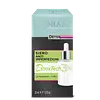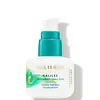What's inside
What's inside
 Key Ingredients
Key Ingredients

 Benefits
Benefits

 Concerns
Concerns

No concerns
 Ingredients Side-by-side
Ingredients Side-by-side

Water
Skin ConditioningPropanediol
SolventC15-19 Alkane
SolventNiacinamide
SmoothingCoco-Caprylate/Caprate
EmollientAcacia Senegal Gum Extract
Panthenol
Skin ConditioningSilica
AbrasiveSodium Hyaluronate
Humectant3,3,5-Trimethylcyclohexyl Succinate Dimethylamide
Skin ConditioningSaccharide Isomerate
HumectantSaccharomyces Ferment
Skin ConditioningLauroyl Lysine
Skin ConditioningBisabolol
MaskingCannabis Sativa Seed Oil
EmollientSimmondsia Chinensis Seed Oil
EmollientAloe Barbadensis Leaf Juice
Skin ConditioningHamamelis Virginiana Leaf Water
AstringentCamellia Sinensis Leaf Extract
AntimicrobialCitrus Aurantium Dulcis Peel Cera
EmollientCitrus Limon Peel
MaskingZingiber Officinale Root Juice
Skin ConditioningXanthan Gum
EmulsifyingGlycerin
HumectantLevulinic Acid
PerfumingSodium Levulinate
Skin ConditioningTocopheryl Acetate
AntioxidantCitric Acid
BufferingSodium Phytate
Parfum
MaskingHydroxyacetophenone
AntioxidantSodium Benzoate
MaskingCaprylyl Glycol
EmollientPhenoxyethanol
PreservativePotassium Sorbate
PreservativeWater, Propanediol, C15-19 Alkane, Niacinamide, Coco-Caprylate/Caprate, Acacia Senegal Gum Extract, Panthenol, Silica, Sodium Hyaluronate, 3,3,5-Trimethylcyclohexyl Succinate Dimethylamide, Saccharide Isomerate, Saccharomyces Ferment, Lauroyl Lysine, Bisabolol, Cannabis Sativa Seed Oil, Simmondsia Chinensis Seed Oil, Aloe Barbadensis Leaf Juice, Hamamelis Virginiana Leaf Water, Camellia Sinensis Leaf Extract, Citrus Aurantium Dulcis Peel Cera, Citrus Limon Peel, Zingiber Officinale Root Juice, Xanthan Gum, Glycerin, Levulinic Acid, Sodium Levulinate, Tocopheryl Acetate, Citric Acid, Sodium Phytate, Parfum, Hydroxyacetophenone, Sodium Benzoate, Caprylyl Glycol, Phenoxyethanol, Potassium Sorbate
Aloe Barbadensis Leaf Juice
Skin ConditioningSqualane
EmollientGlycerin
HumectantSclerocarya Birrea Seed Oil
HumectantSimmondsia Chinensis Seed Oil
EmollientWater
Skin ConditioningPrunus Armeniaca Kernel Oil
MaskingNiacinamide
SmoothingPanthenol
Skin ConditioningAvena Sativa Bran Extract
AbrasiveUbiquinone
AntioxidantLonicera Japonica Flower Extract
Skin ConditioningLycium Barbarum Fruit Extract
AstringentThioctic Acid
AntioxidantPotassium Azeloyl Diglycinate
Skin ConditioningSuperoxide Dismutase
AntioxidantOryza Sativa Extract
AbsorbentCamellia Sinensis Leaf Extract
AntimicrobialSodium Hyaluronate
HumectantTocopheryl Acetate
AntioxidantLeuconostoc Ferment Filtrate
AntimicrobialSoybean Peroxidase
AntioxidantXanthan Gum
EmulsifyingMaltodextrin
AbsorbentCitrus Aurantium Dulcis Peel Extract
Emulsion StabilisingPhenethyl Alcohol
MaskingEthylhexylglycerin
Skin ConditioningAloe Barbadensis Leaf Juice, Squalane, Glycerin, Sclerocarya Birrea Seed Oil, Simmondsia Chinensis Seed Oil, Water, Prunus Armeniaca Kernel Oil, Niacinamide, Panthenol, Avena Sativa Bran Extract, Ubiquinone, Lonicera Japonica Flower Extract, Lycium Barbarum Fruit Extract, Thioctic Acid, Potassium Azeloyl Diglycinate, Superoxide Dismutase, Oryza Sativa Extract, Camellia Sinensis Leaf Extract, Sodium Hyaluronate, Tocopheryl Acetate, Leuconostoc Ferment Filtrate, Soybean Peroxidase, Xanthan Gum, Maltodextrin, Citrus Aurantium Dulcis Peel Extract, Phenethyl Alcohol, Ethylhexylglycerin
 Reviews
Reviews

Ingredients Explained
These ingredients are found in both products.
Ingredients higher up in an ingredient list are typically present in a larger amount.
Aloe Barbadensis Leaf Juice comes from leaves of the aloe plant. Aloe Barbadensis Leaf Juice is best known for helping to soothe sunburns. It is also anti-inflammatory, moisturizing, antiseptic, and can help heal wounds.
Aloe is packed with good stuff including Vitamins A, C, and E. These vitamins are antioxidants, which help fight free-radicals and the damage they may cause. Free-radicals are molecules that may damage your skin cells, such as pollution.
Aloe Barbadensis Leaf Juice also contains sugars. These sugars come in the form of monosaccharides and polysaccharides, folic acid, and choline. These sugars are able to help bind moisture to skin.
It also contains minerals such as calcium, 12 anthraquinones, fatty acids, amino acids, and Vitamin B12.
Learn more about Aloe Barbadensis Leaf JuiceCamellia Sinensis Leaf Extract is derived from the leaves of the tea plant. Black tea, green tea, and oolong tea are all harvested from this plant.
This ingredient has many skin benefits:
This ingredient contains polyphenols, a strong antioxidant. Antioxidants help fight off molecules that damage skin cells.
On top of that, the antioxidants in green tea neutralize free-radicals from the sun. This gives the skin some extra UV protection, but should not replace sunscreen.
Many components of tea have anti-inflammatory properties.
Polyphenols and L-theanine help soothe the skin and reduce irritation. The caffeine in Camellia Sinensis Leaf Extract helps calm inflamed blood vessels.
Other compounds found in tea include: Vitamin Bs, linoleic acid, magnesium, calcium, iron, and zinc.
Research has shown both drinking Camellia Sinensis Leaf Tea and applying it to the skin can help boost skin elasticity and hydration. Studies also show using tea extract may reduce sebum, or oil, production.
Learn more about Camellia Sinensis Leaf ExtractGlycerin is already naturally found in your skin. It helps moisturize and protect your skin.
A study from 2016 found glycerin to be more effective as a humectant than AHAs and hyaluronic acid.
As a humectant, it helps the skin stay hydrated by pulling moisture to your skin. The low molecular weight of glycerin allows it to pull moisture into the deeper layers of your skin.
Hydrated skin improves your skin barrier; Your skin barrier helps protect against irritants and bacteria.
Glycerin has also been found to have antimicrobial and antiviral properties. Due to these properties, glycerin is often used in wound and burn treatments.
In cosmetics, glycerin is usually derived from plants such as soybean or palm. However, it can also be sourced from animals, such as tallow or animal fat.
This ingredient is organic, colorless, odorless, and non-toxic.
Glycerin is the name for this ingredient in American English. British English uses Glycerol/Glycerine.
Learn more about GlycerinNiacinamide is a multitasking form of vitamin B3 that strengthens the skin barrier, reduces pores and dark spots, regulates oil, and improves signs of aging.
And the best part? It's gentle and well-tolerated by most skin types, including sensitive and reactive skin.
You might have heard of "niacin flush", or the reddening of skin that causes itchiness. Niacinamide has not been found to cause this.
In very rare cases, some individuals may not be able to tolerate niacinamide at all or experience an allergic reaction to it.
If you are experiencing flaking, irritation, and dryness with this ingredient, be sure to double check all your products as this ingredient can be found in all categories of skincare.
When incorporating niacinamide into your routine, look out for concentration amounts. Typically, 5% niacinamide provides benefits such as fading dark spots. However, if you have sensitive skin, it is better to begin with a smaller concentration.
When you apply niacinamide to your skin, your body converts it into nicotinamide adenine dinucleotide (NAD). NAD is an essential coenzyme that is already found in your cells as "fuel" and powers countless biological processes.
In your skin, NAD helps repair cell damage, produce new healthy cells, support collagen production, strengthen the skin barrier, and fight environmental stressors (like UV and pollution).
Our natural NAD levels start to decline with age, leading to slower skin repair, visible aging, and a weaker skin barrier. By providing your skin niacinamide, you're recharging your skin's NAD levels. This leads to stronger, healthier, and younger looking skin.
Another name for vitamin B3 is nicotinamide. This vitamin is water-soluble and our bodies don't store it. We obtain Vitamin B3 from either food or skincare. Meat, fish, wheat, yeast, and leafy greens contain vitamin B3.
The type of niacinamide used in skincare is synthetically created.
Learn more about NiacinamidePanthenol is a common ingredient that helps hydrate and soothe the skin. It is found naturally in our skin and hair.
There are two forms of panthenol: D and L.
D-panthenol is also known as dexpanthenol. Most cosmetics use dexpanthenol or a mixture of D and L-panthenol.
Panthenol is famous due to its ability to go deeper into the skin's layers. Using this ingredient has numerous pros (and no cons):
Like hyaluronic acid, panthenol is a humectant. Humectants are able to bind and hold large amounts of water to keep skin hydrated.
This ingredient works well for wound healing. It works by increasing tissue in the wound and helps close open wounds.
Once oxidized, panthenol converts to pantothenic acid. Panthothenic acid is found in all living cells.
This ingredient is also referred to as pro-vitamin B5.
Learn more about PanthenolThis oil comes from the seeds of the desert shrub called Jojoba. It is more commonly known as jojoba oil, a non-comedogenic oil.
Jojoba oil does not contain fragrance and has many fatty-acids, making it a great soothing ingredient.
It also contains Vitamin E, a great moisturizing ingredient. Vitamin E is also an antioxidant and protects your skin against oxidative damage.
This ingredient humectant properties, meaning it helps draw moisture from the air. This helps keep your skin hydrated.
While jojoba has antibacterial properties, it is only able to kill some strains of bacteria.
Studies also show it helps in wound healing. In fact, Indigenous cultures have used jojoba as a moisturizer and to help treat burns for centuries.
Fun fact: Jojoba oil similar to natural human skin sebum, so it has a great effect on dry skin. It is also promising with helping to regulate sebum production.
Due to its fatty acid content, Jojoba oil may not be fungal acne safe. We recommend speaking with a professional if you have any concerns.
Learn more about Simmondsia Chinensis Seed OilSodium Hyaluronate is hyaluronic acid's salt form. It is commonly derived from the sodium salt of hyaluronic acid.
Like hyaluronic acid, it is great at holding water and acts as a humectant. This makes it a great skin hydrating ingredient.
Sodium Hyaluronate is naturally occurring in our bodies and is mostly found in eye fluid and joints.
These are some other common types of Hyaluronic Acid:
Learn more about Sodium HyaluronateTocopheryl Acetate is AKA Vitamin E. It is an antioxidant and protects your skin from free radicals. Free radicals damage the skin by breaking down collagen.
One study found using Tocopheryl Acetate with Vitamin C decreased the number of sunburned cells.
Tocopheryl Acetate is commonly found in both skincare and dietary supplements.
Learn more about Tocopheryl AcetateWater. It's the most common cosmetic ingredient of all. You'll usually see it at the top of ingredient lists, meaning that it makes up the largest part of the product.
So why is it so popular? Water most often acts as a solvent - this means that it helps dissolve other ingredients into the formulation.
You'll also recognize water as that liquid we all need to stay alive. If you see this, drink a glass of water. Stay hydrated!
Learn more about WaterXanthan gum is used as a stabilizer and thickener within cosmetic products. It helps give products a sticky, thick feeling - preventing them from being too runny.
On the technical side of things, xanthan gum is a polysaccharide - a combination consisting of multiple sugar molecules bonded together.
Xanthan gum is a pretty common and great ingredient. It is a natural, non-toxic, non-irritating ingredient that is also commonly used in food products.
Learn more about Xanthan Gum